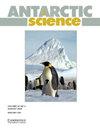Amphipod diversity and metabolomics of the Antarctic sponge Dendrilla antarctica
IF 2
4区 地球科学
Q3 ENVIRONMENTAL SCIENCES
引用次数: 2
Abstract
Abstract The western Antarctic Peninsula harbours a diverse benthic marine community where dense canopies of macroalgae can dominate the shallow subtidal zone (0–40 m or greater). In the lower portion of this range (below 25–35 m depending on topography), invertebrates such as sponges and echinoderms can be found in greater abundance due to reduced competition for space from the algal species. Dendrilla antarctica (previously Dendrilla membranosa) is a common demosponge that thrives in both communities and is known for producing diterpene secondary metabolites as a defence against sympatric sea star and amphipod predators. Omnivorous mesograzers such as amphipods inhabit both communities; however, they are in greatest abundance within the macroalgal canopy. Due to the differences between habitats, it was hypothesized that specific amphipod species not susceptible to the defensive metabolites of D. antarctica would take refuge from predators in the chemically defended sponge. Analysis of the metabolome and amphipod communities from sponges in both habitats found correlations of metabolic profile to both abundance and habitat. These studies serve to inform our understanding of the complex ecosystem of the Antarctic benthos that stands to be dramatically altered by the rapidly changing climate in the years to come.南极海绵树突的片足类多样性和代谢组学
南极半岛西部拥有多样化的底栖海洋群落,其中大型藻类密集的冠层可以统治浅海下带(0-40米或更大)。在这一范围的较低部分(低于25-35米,取决于地形),海绵和棘皮动物等无脊椎动物的数量更多,因为藻类物种对空间的竞争减少了。Dendrilla antarctica(以前的Dendrilla membranosa)是一种常见的demosponge,在两个群落中都很繁荣,并以产生二萜次生代谢物而闻名,以防御同栖海星和片脚类捕食者。片脚类等杂食性中食草动物栖息在这两个群落中;然而,它们在大藻冠层中最为丰富。由于栖息地之间的差异,我们假设特定的片足类物种对D. antarctica的防御性代谢物不敏感,它们会在具有化学防御作用的海绵中躲避捕食者。对两种生境海绵代谢组和片足类群落的分析发现,代谢谱与丰度和生境均存在相关性。这些研究有助于我们了解南极底栖生物复杂的生态系统,在未来几年里,这种生态系统将因气候的迅速变化而发生巨大变化。
本文章由计算机程序翻译,如有差异,请以英文原文为准。
求助全文
约1分钟内获得全文
求助全文
来源期刊

Antarctic Science
地学-地球科学综合
CiteScore
3.60
自引率
6.20%
发文量
42
审稿时长
3 months
期刊介绍:
Antarctic Science provides a truly international forum for the broad spread of studies that increasingly characterise scientific research in the Antarctic. Whilst emphasising interdisciplinary work, the journal publishes papers from environmental management to biodiversity, from volcanoes to icebergs, and from oceanography to the upper atmosphere. No other journal covers such a wide range of Antarctic scientific studies. The journal attracts papers from all countries currently undertaking Antarctic research. It publishes both review and data papers with no limits on length, two-page short notes on technical developments and recent discoveries, and book reviews. These, together with an editorial discussing broader aspects of science, provide a rich and varied mixture of items to interest researchers in all areas of science. There are no page charges, or charges for colour, to authors publishing in the Journal. One issue each year is normally devoted to a specific theme or papers from a major meeting.
 求助内容:
求助内容: 应助结果提醒方式:
应助结果提醒方式:


